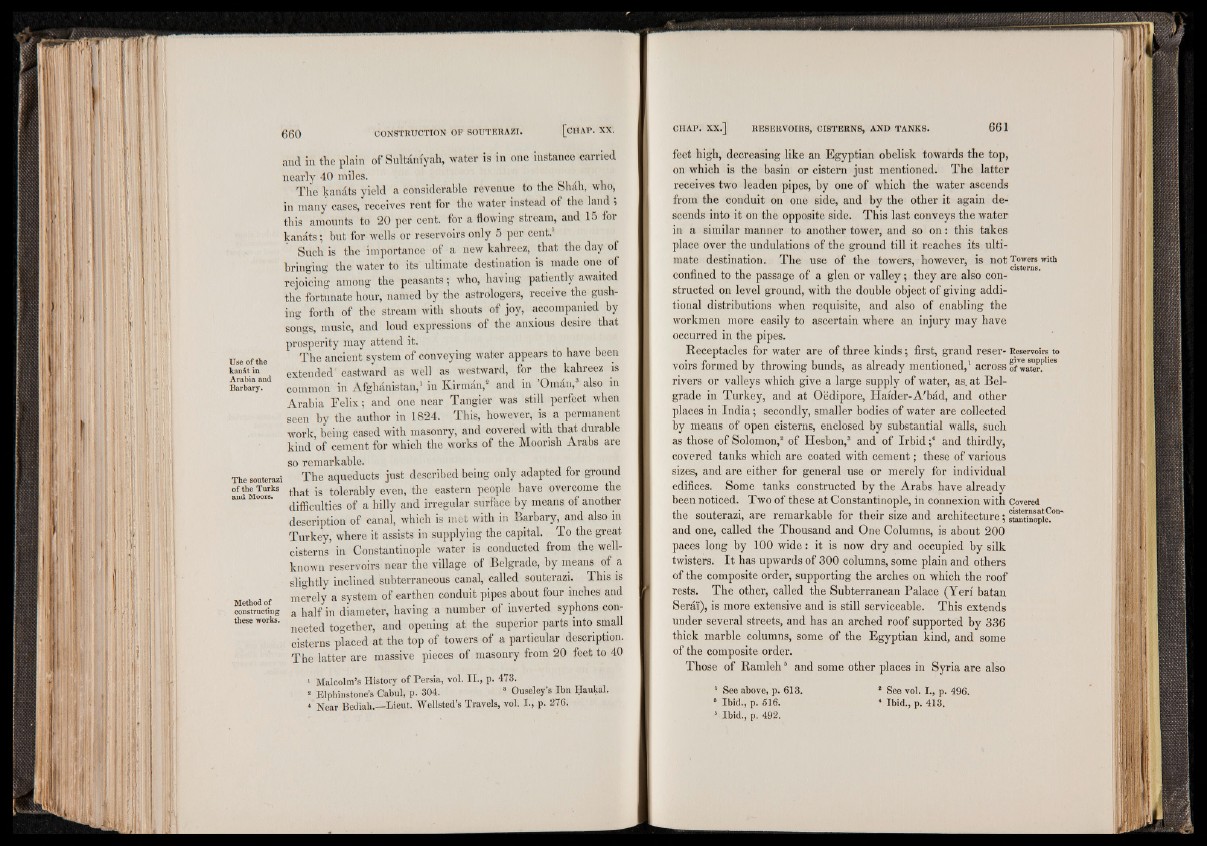
Use of the
kon&t in
Arabia and
Barbary.
The souterazi
of the Turks
and Moors.
Method of
constructing
these works.
and in the plain of SuMniyah, water is in one instance carried
nearly 40 miles.
The kanits yield a considerable revenue to the Shah, who,
in many cases, receives rent for the water instead of the land ,
this amounts to 20 per cent, for a flowing stream, and 15 for
kanats; but for wells or reservoirs only 5 per cent.1
Such is the importance of a new kahreez, that the day of
bringing the water to its ultimate destination is made one of
rejoicing among the peasants; who, having patiently awaited
the fortunate hour, named by the astrologers, receive the gushing
forth of the stream with shouts of joy, accompanied by
songs, music, and loud expressions of the anxious desire that
prosperity may attend it.
The ancient system of conveying water appears to have been
extended' eastward as well as westward, for the kahreez is
common in Afghanistan,1 in Kirman,2 and in ’Oman,3 also in
Arabia Felix; and one near Tangier was still perfect when
seen by the author in 1824. This, however, is a permanent
work, being cased with masonry, and covered with that durable
kind of cement for which the works of the Moorish Arabs are
so remarkable.
The aqueducts just described being only adapted for ground
that is tolerably even, the eastern people have overcome the
diificulties of a hilly and irregular surface by means of another
description of canal, which is met with in Barbary, and also in
Turkey, where it assists in supplying the capital. To the great
cisterns in Constantinople water is conducted from the well-
known reservoirs near the village of Belgrade, by means of a
slightly inclined subterraneous canal, called souterazi. This is
merely a system of earthen conduit pipes about four inches and
a half in diameter, having a number of inverted syphons connected
together, and opening at the superior parts into_ small
cisterns placed at the top of towers of a particular description.
The latter are massive pieces of masonry from 20 feet to 40
1 Malcolm’s History o f Persia, vol. IT, p. 473.
» Blphinstone’s Cabal, p. 304. 3 Ouseley’s Ibn Haukal.
4 Near Bediali.—Lieut. Wellsted’s Travels, vol. I ., p. 276.
feet high, decreasing like an Egyptian obelisk towards the top,
on which is the basin or cistern just mentioned. The latter
receives two leaden pipes, by one of which the water ascends
from the conduit on one side, and by the other it again descends
into it on the opposite side. This last conveys the water
in a similar manner to another tower, and so on: this takes
place over the undulations of the ground till it reaches its ultimate
destination. The use of the towers, however, is not Towers with
confined to the passage of a glen or valley; they are also constructed
on level ground, with the double object of giving additional
distributions when requisite, and also of enabling the
workmen more easily to ascertain where an injury may have
occurred in the pipes.
Receptacles for water are of three kinds; first, grand reser- Reservoirs to
voirs formed by throwing bunds, as already mentioned,1 across IjTwaterf1'68
rivers or valleys which give a large supply of water, as. at Belgrade
in Turkey, and at Oedipore, Haider-A'bad, and other
places in India; secondly, smaller bodies of water are collected
by means of open cisterns, enclosed by substantial walls, such
as those of Solomon,2 of Hesbon,3 and of Irbid ;4 and thirdly,
covered tanks which are coated with cement; these of various
sizes, and are either for general use or merely for individual
edifices. Some tanks constructed by the Arabs have already
been noticed. Two of these at Constantinople, in connexion with Covered
the souterazi, are remarkable for their size and architecture; sSntinopie?°n'
and one, called the Thousand and One Columns, is about 200
paces long by 100 wide: it is now dry and occupied by silk
twisters. It has upwards of 300 columns, some plain and others
of the composite order, supporting the arches on which the roof
rests. The other, called the Subterranean Palace (Yeri batan
Serai), is more extensive and is still serviceable. This extends
under several streets, and has an arched roof supported by 336
thick marble columns, some of the Egyptian kind, and some
of the composite order.
Those of Ramleh5 and some other places in Syria are also
1 See above, p. 613.
• Ibid., p. 516.
“ Ibid., p. 492.
a See vol. I., p. 496.
4 Ibid., p. 413.